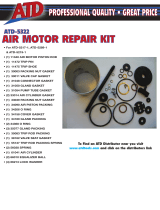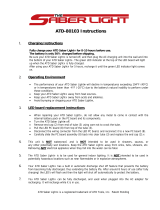
• Do not allow the hose to kink, twist, curl, crush, cut
or bend so tightly that the fluid flow within the hose is
blocked or reduced. Periodically inspect the hose for
wear, because any of these conditions can damage
the hose and possibly result in personal injury.
• Do not pull, position or move setup by the hose. Do-
ing so can damage the hose and possibly cause per-
sonal injury.
• Hose material and coupler seals must be compatible
with hydraulic fluid used. Hoses also must not come
in contact with corrosive materials such as battery
acid, creosote-impregnated objects and wet paint.
Hose deterioration due to corrosive material can re-
sult in personal injury. Never paint a coupler or hose.
• The user must be a qualified operator familiar with the
correct operation, maintenance, and use of cylinders.
Lack of knowledge in any of these areas can lead to
personal injury.
• Read and understand all safety and warning decals
and instructions.
• Use only approved accessories and approved hydrau-
lic fluid. Hoses, seals and all components used in a
system must be compatible with the hydraulic fluid
used.
• Do not exceed the rated capacity of the cylinder. Ex-
cess pressure can result in personal injury.
• Inspect each cylinder and coupler before each use to
prevent unsafe conditions from developing.
• Do not use cylinders if they are damaged, altered or
in poor condition.
• Do not use cylinders with bent or damaged coupler or
damaged threads.
• Under certain conditions, the use of an extension with
a hydraulic cylinder may not be advisable and could
present a dangerous condition.
• Avoid pinch points or crush points that can be cre-
ated by the load or parts of cylinder.
• To help prevent material
fatigue if the cylinder is to
be used in a continuous
application, the load
should not exceed 85% of
the rated capacity.
• Cylinder must be on a
stable base which is able
to support the load while
pushing or lifting.
• Ensure cylinder is fully
engaged into/onto adapt-
ers, extension accessories.
4
• To help prevent personal injury, use shims, friction ma-
terial or constraints to prevent slippage of the base or
load.
• Do not off-center loads on a cylinder. The load can tip
or the cylinder can "kick out" and cause personal in-
jury.
• Do not use the locking collar on threaded piston as a
stop. The threads may shear resulting in loss of the
load.
• Do not create an overload condition where force ex-
erted by one cylinder will intensify downward force on
another cylinder.
• If this component is used to lift or lower loads, be
certain that the load is under operator control at all
times and that others are clear of the load. Do not
drop the load.
• As the load is lifted, use blocking and cribbing to guard
against a falling load.
• Never allow personnel to work on, under or around a
load before it is properly supported by appropriate me-
chanical means. Never rely on hydraulic pressure alone
to support load.
• All personnel must be clear before lowering.
• Never try to disassemble a hydraulic cylinder, Refer
repairs to qualified, authorized personnel.
IMPORTANT
• Keep cylinder clean at all times.
• When the cylinder is not is use, keep the ram(s) fully
retracted.
• Use an approved, high-grade pipe thread sealant to
seal all hydraulic connections. Teflon tape can be used
if only one layer of tape is used and it is applied care-
fully (two threads back) to prevent the tape from being
introduced into hydraulic system. A piece of tape could
travel through the system and obstruct the flow of fluid
and adversely affect function.
• Never attach ANY component not authorized by manu-
facturer.
• Never use other than factory provided and/or author-
ized fasteners.
KNOW YOUR SYSTEM
Your cylinder, hose(s), couplings and pump all must be
rated for the same maximum operating pressure, cor-
rectly connected and compatible with the hydraulic fluid
used. An improperly matched system can cause the sys-
tem to fail and possibly cause serious injury. If you are in
doubt, consult your nearest ATD Hydraulics Dealer.
Center loads on cylinder
!
!

















